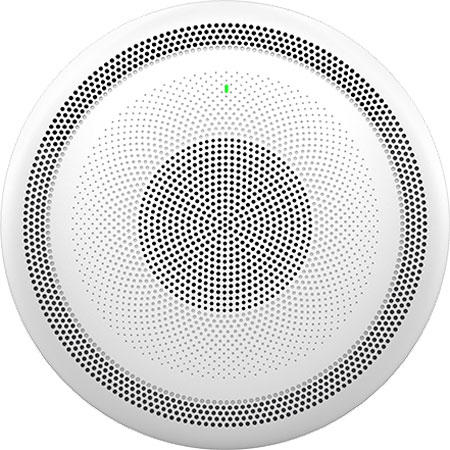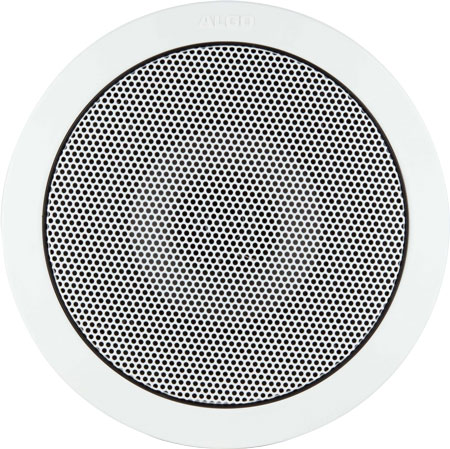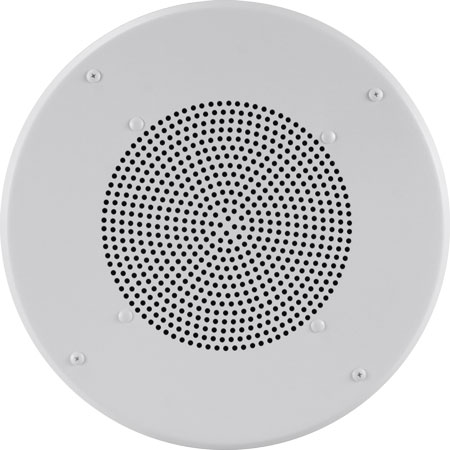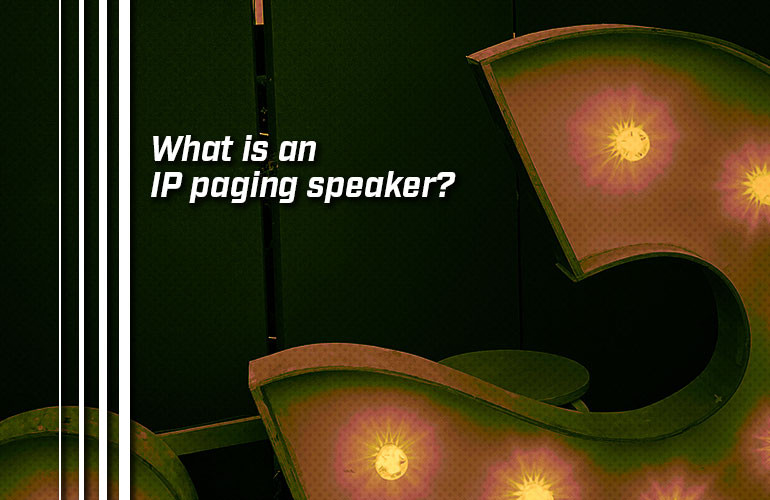IP Paging Speakers are an upgrade for public address (PA) systems. In this blog, we introduce what IP paging speakers are, cover how they’re managed, and give you a sampling of the advantages they offer.
If you want more complete information, check out our clear, detailed Paging Systems Buyer’s Guide.
Let’s get started!

An introduction to IP paging speakers
Think of IP paging speakers as the paging equivalent of VoIP phones.
Traditional telephones run over dedicated telephone cables and the PSTN infrastructure. VoIP phones run over internet technologies like Ethernet cables and Wi-Fi.
Analog paging speakers run over dedicated cables with a whole separate system of amplifiers, zone paging equipment, and so on.
IP paging speakers run over internet technologies. Typically, an IP speaker connects to the network via a standard Ethernet cable. (Recently, Wi-Fi paging speakers have started to appear, like Grandstream GSC3516.)
They are controlled by an IP paging system, which is a software-based platform, running on computers, and which can be integrated with your other communications as part of a VoIP phone system. This arrangement is different from traditional analog paging systems, which require a whole series of dedicated devices, which are only used for that system.
The depth and variety of IP paging equipment is exemplified by manufacturers like Valcom, who make a huge range of IP paging endpoints including, for example, IP paging speakers with integrated clocks or digital signage, and Viking Electronics, who make IP paging speakers with Enhanced Weather Protection, making them durable in harsh conditions.

IP paging speakers are convenient
By being network-connected devices, IP paging speakers are both more convenient and more feature-rich than analog speakers.
One of the big features that make them more convenient is that running Ethernet cable is simple, comparatively cost-effective, and doesn’t require a specialized technician. Ethernet cabling is widely available and, given how much of our world runs over the internet, extremely unlikely to be phased out in the near future.
You can also power IP paging speakers through Ethernet cables using Power Over Ethernet (PoE). PoE is a well-established industry standard for pushing power through Ethernet cables. Using PoE reduces the amount of cabling and power infrastructure you require. (While almost all IP speakers do support PoE, check to ensure support before purchase.)
There are even some IP paging manufacturers who have started releasing satellite speakers, like Algo 1198. This satellite speaker provides the exact same acoustical performance as its “parent” speaker, Algo 8198. But it connects to the network by daisy-chaining through the parent speaker, and you can even power both speakers using one Ethernet cable via PoE+.

IP paging systems are convenient, too
IP paging speakers are more convenient to manage. You manage them via an IP paging system, which is a software-based platform. It allows you to view and control the whole paging system from one workstation.
Most IP paging systems operate using SIP, which is an open-source communications protocol that’s also the basis for most VoIP phone systems. Since they use the same protocol, SIP paging systems can be integrated with VoIP systems as part of a unified communications (UC) solution.
The advantages of IP paging system are too numerous to list, but here are a few.
You can setup paging zones more easily, since you don’t need to setup hard-wired zones, as you do with an analog system. Paging zones mean you send a message or music to specific speakers in the system, not every speaker. You can even setup dynamic zones, which are impossible with previous paging systems.
If you have many speakers playing the same message, you can setup Multicast to improve efficiency and reduce network load. Without getting too technical, here’s what Multicast entails. You setup a specific IP address for broadcasts. Multicast speakers “listen” for messages from that IP address, playing them when they’re sent out. This system is much more efficient than requiring the broadcast to be sent to every speaker individually. (Most IP paging speakers and systems support Multicast, but ensure compatibility before purchase.)
You can setup and modify paging schedules more easily, because all you need to do is type times into the paging system’s interface. These schedules will always be accurate, even automatically compensating for Daylight Saving Time. An IP paging system’s time is set using the Network Time Protocol (NTP). Think about how your smartphone always has accurate time: it’s the exact same thing. Literally. Your phone also uses NTP.
You can scale the paging system more easily, because all you need to do is connect a new speaker to your network for it to be available to the paging system.
As you can see, there are many advantages to IP paging speakers!

